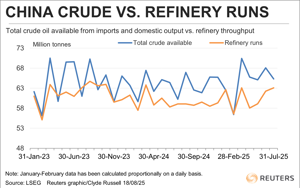China still storing crude oil even as refinery runs rise
China's refiners lifted their processing rates in July, but strong crude oil imports and domestic output meant there was still a surplus of more than .5 MMbpd available for storage.
The volume of surplus crude in July fell to 530,000 bpd from 1.42 MMbpd in June, according to calculations based on official data.
Despite the decline in surplus oil, the key point is that refiners are still likely adding to stockpiles, which will allow them to trim imports should prices rise to levels they believe are not justified by market fundamentals.
(click image to enlarge)
China does not disclose the volumes of crude flowing into or out of strategic and commercial stockpiles, but an estimate can be made by deducting the amount of oil processed from the total of crude available from imports and domestic output.
Refiners processed 14.85 MMbpd of crude in July, up 8.9% from the same month last year, but down 2% from June, although that month was the highest since September 2023.
The utilization rate rose to 71.84% in July, up 1.02% from June and 3.56% from July 2024, according to official data released on Aug. 15.
China, the world's biggest crude importer, saw arrivals of 11.11 MMbpd in July, while domestic production was 4.27 MMbpd. This meant that a total of 15.38 MMbpd was available to refiners, and subtracting the 14.85 MMbpd that was processed leaves a surplus of 530,000 bpd.
For the first seven months of the year China's surplus crude amounted to 980,000 bpd, the bulk of this being built up from March onwards as crude imports and domestic output rose at a faster rate than refinery processing.
It is worth noting that not all of this surplus crude is likely to have been added to storage, with some being processed in plants not captured by the official data.
But even allowing for gaps in the official data, it is clear that from March onwards China has been importing crude at a far higher rate than it needs to meet its domestic fuel requirements.
Crude imports. The question for the market is whether the recent strength in crude imports will persist or if they will decline in coming months as refiners use more of their stockpiled oil.
The key is generally prices, with China's refiners showing a pattern of increasing imports when they deem prices to be reasonable, but cutting back when they believe they have risen too high, or too quickly.
The increase in crude imports from March onwards coincided with a declining trend in prices, with global benchmark Brent crude falling from a high of $82.63 a barrel on January 15 to a four-year low of $58.50 on May 5.
Since then, the picture has been more volatile, with the brief conflict between Israel and Iran, later joined by the United States, sending Brent to a high of $81.40 a barrel on June 23, before prices slipped back to around $65.57 in early Asian trade on Monday.
It's possible that the rising prices from the May low to the June high may see China trim imports for cargoes arriving in late August and early September, as this would be the time period in which they were arranged.
The move by top exporter Saudi Arabia to increase its official selling prices for both August- and September-loading cargoes may also see China buy fewer cargoes. But if refinery processing rates continue to rise and Chinese refiners continue their recent trend of exporting more fuels such as diesel and gasoline, imports of crude may hold up in coming months.
The views expressed here are those of Clyde Russell, a columnist for Reuters.







Comments